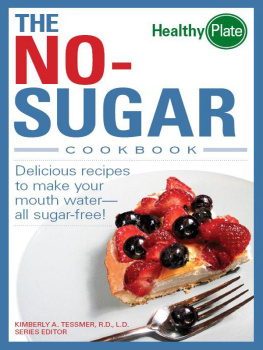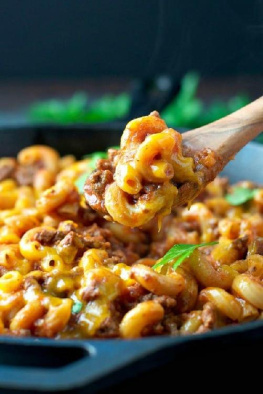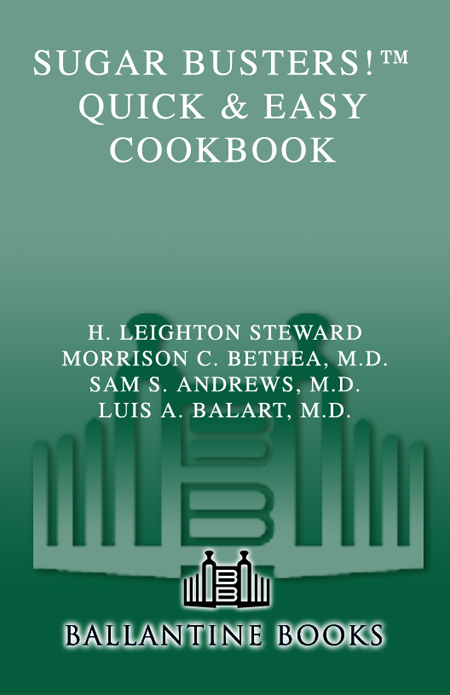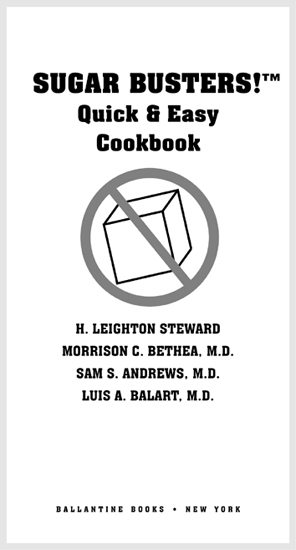Foreword
The SUGAR BUSTERS! lifestyle was first chronicled in an author-published trade paperback book entitled SUGAR BUSTERS! Cut Sugar to Trim Fat in 1995. It was authored by a Fortune 500 CEO with a Master of Science degree and three medical doctors with specialties that bear on providing good health. Easily translated into knowledge and experience regarding the importance of nutrition in either enhancing or negatively affecting your health, their areas of expertise include cardiovascular and thoracic surgery (heart surgeon), endocrinology (gland specialist, which includes the pancreas), and gastroenterology-hepatology (liver specialist).
The dietary lifestyle proposed is a simple way of eating that allows you to eat most foods in normal quantities, possibly even in larger quantities than you presently consume. You can have three full meals a day and even appropriate snacks. There are only a few things you cannot consume on this diet. They are the carbohydrates that cause an intense secretion of insulin, which causes your body to store excess sugar as fat. These carbohydrates include red and white potatoes, corn, white rice, highly processed grain products, beets, carrots, and, of course, the refined sugars and products made with such sugars. Beyond that, most foods are acceptable!
How much success have people had with this way of eating? While no rigorous clinical trials have been conducted, more than 95 percent of respondents have reported losing significant quantities of weight. Very importantly, respondents have experienced an average 15 percent reduction in cholesterol levels, significantly lower levels of blood serum triglycerides, improvement in reducing or eliminating indigestion, improvement in those suffering with episodes of hypoglycemia (low blood sugar), a reduction in the number of or elimination of migraine headaches, and a sustained pick-up in energy level. Very significantly, nearly all diabetics have experienced a reduction in blood sugar levels, with most requiring less medication and many requiring none at all.
Now, after having observed the tremendous success people have had following this lifestyle as well as receiving thousands of testimonials regarding the success others have had, the authors want to respond to the ever-present requests that they provide recipes to help people easily follow this beneficial way of eating.
This cookbook features recipes that, while healthful, savory, and filling, can be prepared quickly and easily to help you continue to experience these beneficial health effects and to help you who never seem to have enough time to cook meals requiring an hour or more to assemble. It also provides tips on how to plan ahead and prepare, or simply get some ingredients stockpiled, some items marinated, or a pot of beans going that will make it convenient later in the week to cook some great 20-minute dishes.
SUGAR BUSTERS! Quick & Easy Cookbook is designed to be user-friendly. It is divided into three primary sections that consist of recipes for breakfast, lunch, and dinner. Some overlap occurs, mainly between lunch and dinner recipes, but to facilitate preparation of a meal on short notice, the book is organized so if you want a recipe for a quick lunch menu, you shouldn't have to thumb through the entire book to find a suitable selection. Also included are other regular chapters on stocking your pantry, using spices, herbs, and seasonings, vegetables, appetizers, desserts, etc., as well as frequent tips on how to vary recipes to your taste or on what the food items in your chosen recipe contain in the way of beneficial nutrients.
The SUGAR BUSTERS! lifestyle is a logical, practical, and highly flexible eating plan and contains no requirements to count, weigh, and measure that cause so many diets to be discarded. Just as the original SUGAR BUSTERS! book enabled folks across the country to lose weight and feel better while enjoying foods they had denied themselves for years, including fabulous restaurant meals, the SUGAR BUSTERS! Quick & Easy Cookbook will show you how to re-create many all-time favorite dishes in your kitchen and provide you with the know-how to create and adapt your own recipes in accordance with your own taste and the healthy SUGAR BUSTERS! way of eating.
Finally, for those of you confused by the various comments quoted in the media that are critical of certain aspects of this way of eating, a chapter is provided to set the record straight and put you at ease regarding these ofttime self-serving or curiously uninformed comments.
The authors would like to acknowledge Barry Bluestein and Kevin Morrisey who tested the recipes, organized the recipes in a consistent pattern of presentation, and even contributed some recipes of their own that fit nicely into the SUGAR BUSTERS! lifestyle.
I | Introduction
The underlying principles of the SUGAR BUSTERS! lifestyle can be found in medical textbooks. Despite the understandable confusion you may have about the role of refined and natural sugars (carbohydrates) in providing fat to the body's fat cells, the undeniable fact is that most sugar you eat is converted to fat in your body. Your confusion lies in the fact that some (by all means not all!) nutritionists and spokes-persons for the nutrition or sugar industry associations make public statements like: That is absurd! Everybody knows that sugar does not turn to fat!, or The only way you can get diabetes is through heredity!, or Well, your diet certainly won't keep the weight off long term! So yes, you have had a right to be confused. Some nutritional theories do appear to make sense, but often they are inconsistent with basic physiological facts or the results of controlled studies. SUGAR BUSTERS! relies upon established medical facts or carefully controlled study results.
How Sugar Causes Your Body to Store Fat
The hormone that signals your body's cells to be receptive to the storage of fat is insulin, which is why it is so often referred to as the fat storage hormone. When you consume sugar, either from the refined types or the natural carbohydrates you eat, the rising blood sugar triggers the release of insulin. Insulin plays the key role in driving blood sugar back down to its normal level. So, an obvious answer to help control your body's storage of fat is to modulate downward (reduce) the amount of insulin you cause your pancreas to secrete. To do that, simply do not eat as much sugar, especially those that cause your blood sugar to rise so rapidly. When you do eat sugar, get it primarily from high-fiber carbohydrates like those that are included in many of the recipes contained in this book.







